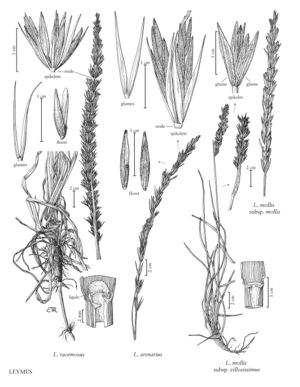Leymus arenarius
Plants weakly cespitose, rhizomatous, strongly glaucous. Culms 50-150 cm tall, (2) 3-6 mm thick, usually glabrous throughout, occasionally pub¬escent distally to 5 mm below the spike. Leaves exceeded by the spikes; ligules 0.3-2.5 mm; blades 3-11 mm wide, with 15-40 adaxial veins. Spikes 12-35 cm long, 15-25 mm wide, usually with 2 spikelets per node; internodes 8-12 mm, surfaces glabrous, edges ciliate. Spikelets 12-30 mm, with 2-5 florets. Glumes 12-30 mm long, 2-3.5 mm wide, lanceolate, tapering from below midlength, stiff, glabrous towards the base and usually distally, sometimes pubescent distally, the central portion thicker than the margins, 3 (5) -veined at midlength, keeled or rounded over the midvein, midveins and sometimes the margins with hairs to about 1.3 mm, apices acuminate; lemmas 12-25 mm, densely villous, hairs 0.3-0.7 mm, 5-7-veined, acute, occasionally awned, awns to 3 mm; anthers 6-9 mm, dehiscent. 2n = 56.
Distribution
Mich., Wis., N.Y., Ill., Ind., Greenland, N.W.T., Ont., Que., Conn.
Discussion
Leymus arenarius is native to Europe. It has become established in sandy habitats around the Great Lakes and the coast of Greenland. It has also been found at a few other widely scattered locations. It is sometimes cultivated, forming large, attractive, blue-green clumps, but its tendency to spread may be undesirable.
Selected References
None.
Lower Taxa
"decumbent" is not a number."/2-33/4timesthelengthof" is not declared as a valid unit of measurement for this property.
